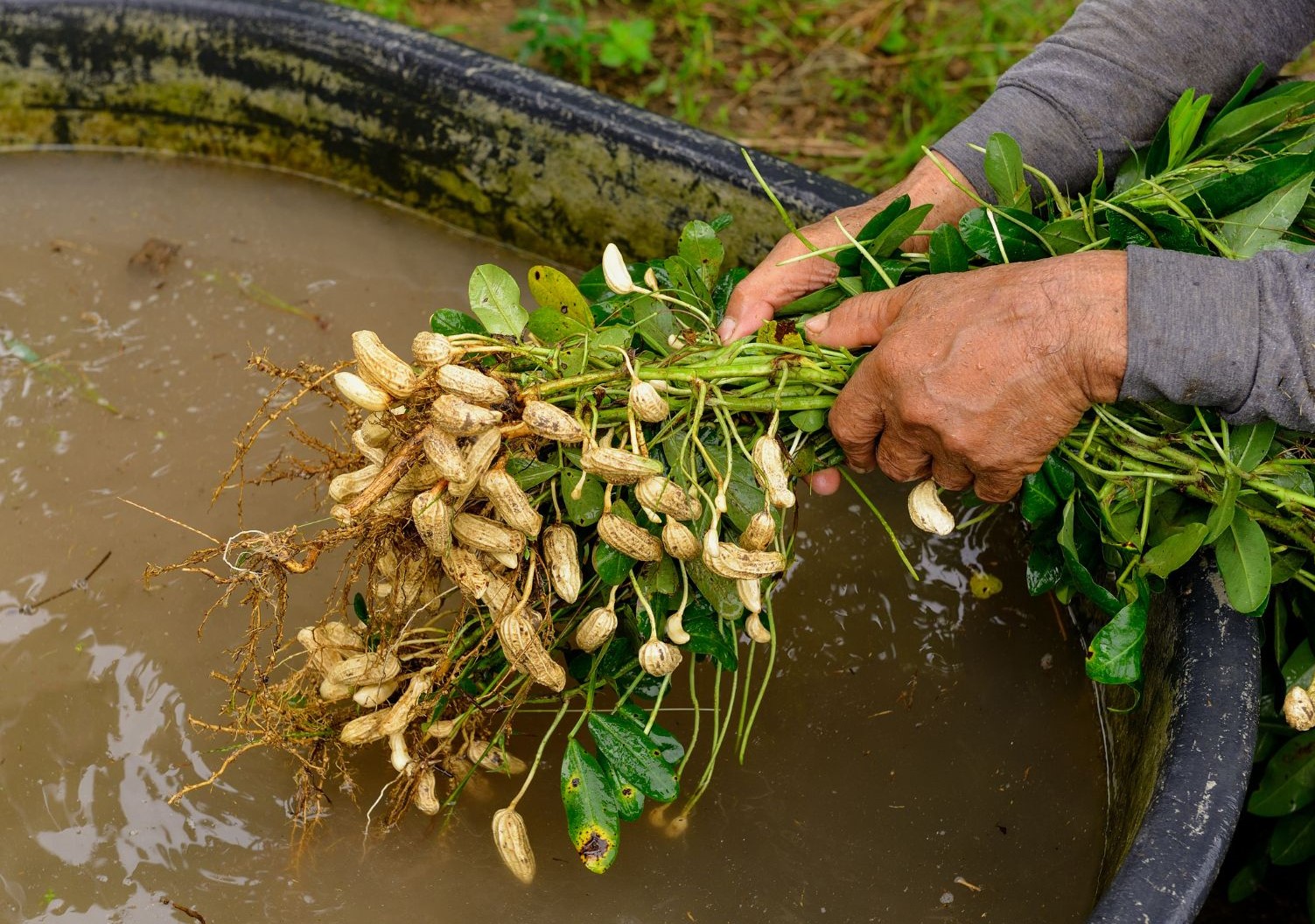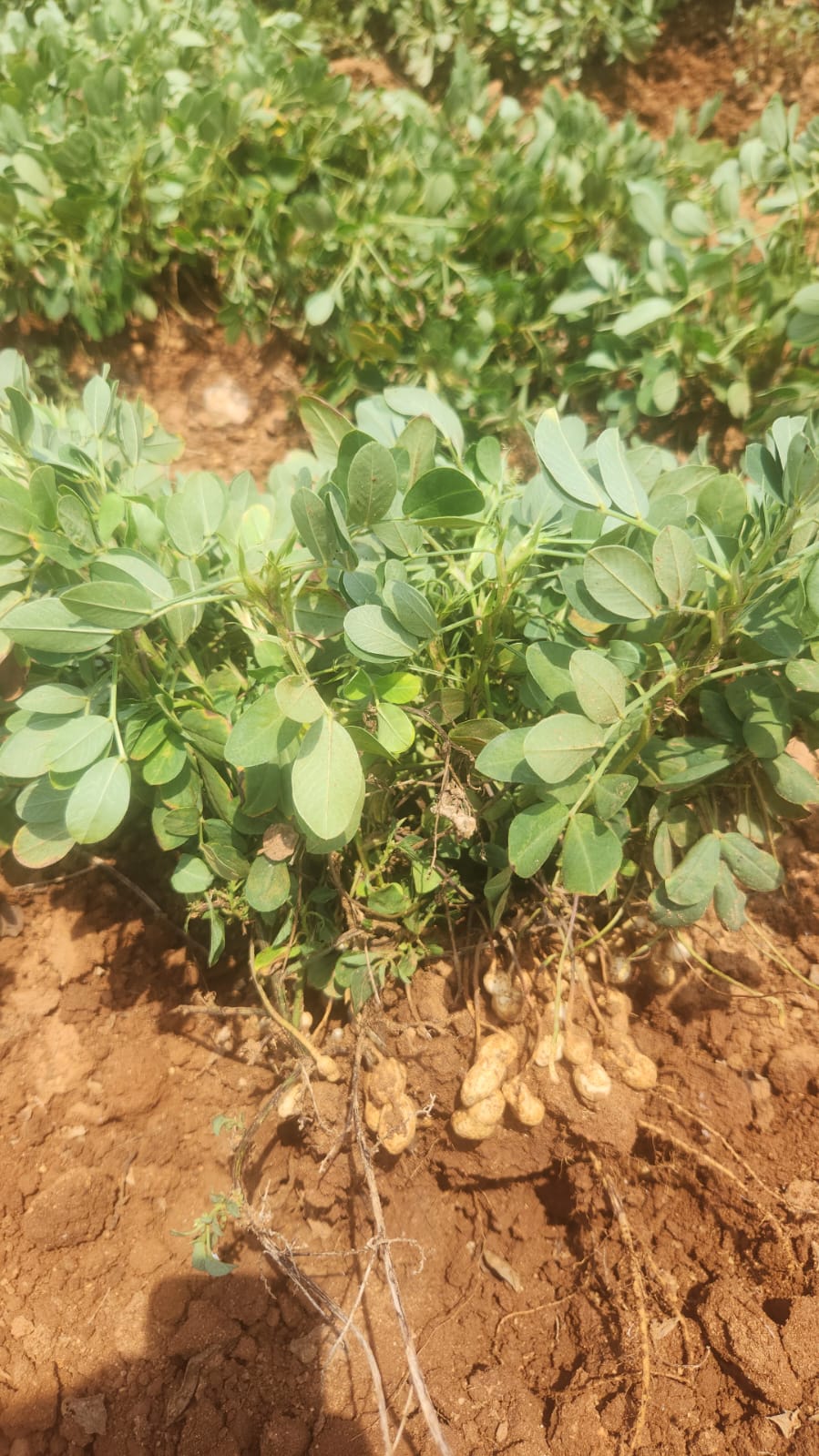Harvesting, Drying, Curing, and Storage of Groundnut

This post is also available in:
This post is also available in:
![]() हिन्दी (Hindi)
हिन्दी (Hindi)
Groundnut harvesting time is very important for yield and quality. Premature harvesting of groundnut pods decreases the yield, oil percentage, and quality of seeds. Suppose we delay the harvesting after the stage of physiological maturity of seeds. In that case, this can result in increased Aspergillus flavus infection and aflatoxin contamination in pods/seeds, and many pods may be fallen/left in the soil due to a weakening of pegs. Some of the Spanish bunch-type varieties will start germination if harvesting is delayed.
The groundnuts are ready for harvesting when the pods are fully mature and have turned brown or black. This can be assessed by pulling one or two plants and observing the pod color, hardness, and, most importantly, the inner skin of the pod/shell (once we break the pod) should turn brown. And a fully matured pod can often be challenging to split open with the pressure of the fingers. Long periods of rain immediately before harvest may result in yield loss and deterioration of the quality of groundnuts.

How to harvest groundnuts
Different ways of harvesting groundnut exist according to the availability of resources of the farmer. The plants are lifted from the soil with pods intact, either by hand or using a mechanical harvester.
(1) Application of sprinkler irrigation for an hour and manually pull the groundnut plants.
(2) Provide light surface irrigation 2-3 days before harvest and use a blade harrow that cuts the plant roots 12-15 cm below the soil surface. Then later, manually pull the plants.
(3) In the areas where irrigation water is scarce, use a plow or tractor-driven digger to lose the soil. Then manually remove the plants.
Harvested groundnut plants are either stacked or left upright on the field ground for a few days for air and sun drying (on bright sunny days). Later, the pods are then separated from the vines (stripping).
Postharvest handling of groundnuts
Once the pods are separated from the plants, the farmer can clean them, removing the mud/soil particles, stem sticks, immature pods, etc. The cleaned pods should be properly sun-dried for 2-3 days or can be placed in the air drier at 27-38° C for two days to reach a moisture content of 7-8 % to avoid the development of aflatoxin caused by Aspergillus flavus (yellow mold). If the pods are dried in the sun, they should be spread out in a single layer on a clean, dry surface. The pods should be turned regularly to ensure that they dry evenly. The drying process can take 2-3 days, depending on the weather conditions. Curing is the process of decreasing the moisture content of groundnut after harvest to a safe level for long-term preservation.
There are many challenges associated with groundnut postharvest management practices. These challenges are linked to poor drying and storage, resulting in microbial contamination and pest (insect, rodent, etc.) attacks (Anderson et al., 1995; Craufurd et al., 2006). Postharvest losses due to pests and poor management practices can reach up to 70% after six months of storage (Oaya et al., 2012). These poor management practices not only increase losses but also reduce the quality and value of the groundnuts and hence access to the market and market price.

How to store groundnuts properly
Groundnuts are primarily stored unshelled to protect them better from insect pest attacks. It is well known that pods are less susceptible to insect pests’ damage than grains (Rao et., 2010; Baributsa et al., 2017). The cured pods are stored in a cool, dry place. The ideal storage temperature is 10-15°C, and the relative humidity should be 65-70%. Under these conditions, the groundnuts can be stored for up to 10 months without significantly losing quality. Generally, gunny bags are used for storing groundnut pods; however, the commercial availability of chemical-free hermetic technologies such as PICS (Purdue et al.) bags are also recommended, which effectively preserve the groundnut pods against insect pest attack and aflatoxin mitigation.
Here are some tips for ensuring the quality of your groundnuts during harvesting, drying, curing, and storage:
- Harvest the groundnuts at the right time. If you harvest them too early, the pods will be immature and have a poor flavor. If you harvest them too late, the pods will be overripe, and the kernels will be shriveled.
- Dry the pods thoroughly. If the pods are not dried properly, they will be susceptible to mold and decay.
- Cure the pods properly. Curing helps to improve the flavor and storage quality of the groundnuts.
- Store the groundnuts in a cool, dry place. This will help to prevent the pods from becoming moldy or infested with insects.
By following these tips, we can ensure that groundnuts will be of the highest quality and last for a long time.
References:
- Anderson W. F., Holbrook C. C., Wilson D. M., & Matheron M. E (1995).Evaluation of preharvest aflatoxin contamination in some potentially resistant peanut genotypes. Peanut Science, 22(1), 29-32. 10.3146/pnut.22.1.0007.
- Baributsa D., Abdoulaye T., Lowenberg-DeBoer J., Dabiré C., Moussa B., Coulibaly O., & Baoua I (2014).Market building for post-harvest technology through large-scale extension efforts. Journal of Stored Products Research, 58, 59-66. 10.1016/j.jspr.2014.02.012.
- Craufurd P. Q., Prasad P. V. V., Waliyar F., & Taheri A (2006).Drought, pod yield, pre-harvest Aspergillus infection and aflatoxin contamination on groundnut in Niger. Field Crops Research, 98(1), 20-29. 10.1016/j.fcr.2005.12.001.
- Oaya C. S., Malgwi A. M., & Samaila A. E (2012).Damage Potential and Loss Caused By the Groundnut Bruchid Caryedon Serratus Olivier (Coleoptera: Bruchidae) on Stored Groundnut and Tamarind in Yola. IOSR Journal of Agriculture and Veterinary Science, 1(6), 58-62. 10.9790/2380-0165862.
- Ranga Rao G. V., Rameshwar Rao V., & Nigam S. N (2010).Post-harvest insect pests of groundnut and their management. International Crops Research Institute for the Semi-Arid Tropics.
Further reading:
Groundnut: Plant Information, History, Uses and Nutrition Value
Principles of selecting the best varieties of Groundnut: A Comprehensive Guide
Groundnut Soil requirement, Soil preparation and Planting
Weed Management in Groundnut Farming
Fertilizer requirement for Groundnut Cultivation
Irrigation Requirement and Methods for Groundnut Cultivation
Groundnut Diseases and Management Practices
Groundnut Insects, Pests, and their Management
Harvesting, Drying, Curing, and Storage of Groundnut









































































